|
– Part 2: Tech Specs, Special Features and Summary –
All six features were sourced from high definition masters by Sony, with Framed, 711 Ocean Drive, The Mob and Affair in Trinidad framed 1.37:1, while Tight Spot and Murder by Contract are framed 1.85:1. All have solid black levels, a must for any noir film, but these are at their deepest and the contrast at its punchiest on Framed, Affair in Trinidad and Tight Spot. 711 Ocean Drive and The Mob have the most generous tonal range, and while detail is generally crisp and well defined, there’s a very slight softness to 711 Ocean Drive when stood beside is companions, but it still looks fine otherwise. All are in very good shape, with next to no dust spots and little sign of any former wear, though there are some visible scratches on the extreme left side of frame for a short while on 711 Ocean Drive. All display a fine film grain and are completely stable in frame. I’ve no complaints here.
All six films have Linear PCM 1.0 mono soundtracks and all are of a similar quality, with the expected restrictions in dynamic range but clear reproduction of dialogue, effects and music and no obvious signs of wear or damage. The music often sounds fuller than you might expect (I first noticed this on Framed, the oldest of the films here) and intermittently the sound effects are particularly good (barking dogs and rain on Affair in Trinidad, for example).
Optional English subtitles for the deaf and hearing impaired are available on all six films, and all of the short films in the special features.
FRAMED
Audio Commentary with Imogen Sara Smith
Author and critic Imogen Sara Smith examines a film she clearly holds in high regard, noting early the importance of almost all details in a film that was one of the one that helped to migrate noir out of the city and into the suburbs. We get interesting detail on many of the actors, especially Glenn Ford, as well as screenwriter Ben Maddow, cinematographer Burnett Guffey, costume designer Jean Louis, director Richard Wallace and more. There’s some always useful coverage on the impact of the blacklist on some of those who worked on the film, the origins and role of the femme fatale in noir cinema, and there’s a handy overview of the Columbia noir cycle. There’s plenty more here. Good stuff.
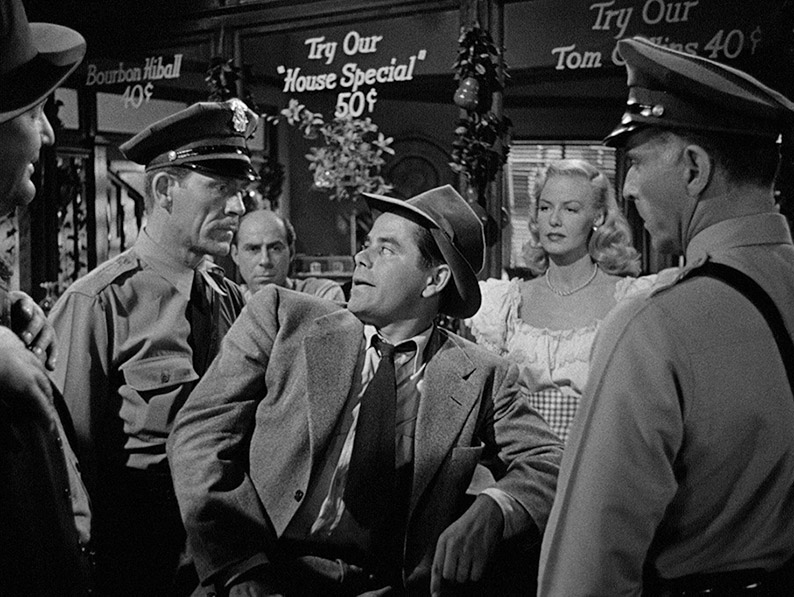
Image Gallery
18 screens of promotional stills, lobby cards and posters.
The Steps of Age (1950) (24:28)
Written and directed by Framed’s screenwriter, Ben Maddow, this short film for The Films Library, Department of Human Resources, is the first in a Mental Health Film Board series on the emotions of everyday living and looks at the challenges of ageing through the eyes of the recently widowed Mrs. Potter. It’s a slightly simplistic but still touching and pleasingly low-key affair whose greatest strength is its air of realism – despite the characters being played by actors, the feeling that you’re watching a documentary is sometimes quite striking. As someone who lives alone and is getting on a bit now, it’s not a film I found particularly comforting, however.
The Three Stooges in ‘Up in Daisy’s Penthouse’ (1953) (16:37)
Shemp, Larry and Moe discover that their oil tycoon father is divorcing their mother in order to marry a younger gold-digger, and they thus head over to his place with the intention of stopping the marriage and bringing him home. Armed with a title that reads like an outrageous innuendo, the film begins with the three boys in bed together in that oddly innocent manner that time has since passed by, and with their father played also by Shemp, the stage for that old comedy favourite of mistaken identity is set. The usual head-slapping and eye-poking aside, there are a couple of rather smart gags in here, the best of which sees Shemp trying everything to remove a clothing stain that is actually a small patch of light from the window, one that he blocks out every time he moves round to clean it. It ends on a Jimmy Durante gag that will likely be lost on younger viewers.
711 OCEAN DRIVE
Audio Commentary with Glenn Kenny
Author and critic Glenn Kenny kicks off by revealing that he could find no evidence that the film’s opening caption – which proclaims that gangland figures tried to stop production and that the film had to be made under police protection – is remotely true, then gets stuck into the film itself and those involved in its making. He talks about Edmond O’Brien and how Mal Granger both conforms to and differs from the standard noir lead character profile, provides brief biographies of a number of other actors in the film, and looks at the career of director Joseph M. Newman. There is some describing of the on-screen action, but this is always brief and used as a jumping-off point for the examination of characters, plot points, technique or discussion of the film and the genre in which it sits. He also picks up on the unprecedented use of the term, “got him by the short hairs” at a time when such a phrase would normally have censored by the Production Code.
Theatrical Trailer (2:36)
Introduced by Edmond O’Brien, who promotes the claim that the film was made with a gun at its back because gangsters tried to prevent it being made, this is otherwise standard stuff, with fans wipes, newspaper seller narration and a couple of spoilers.
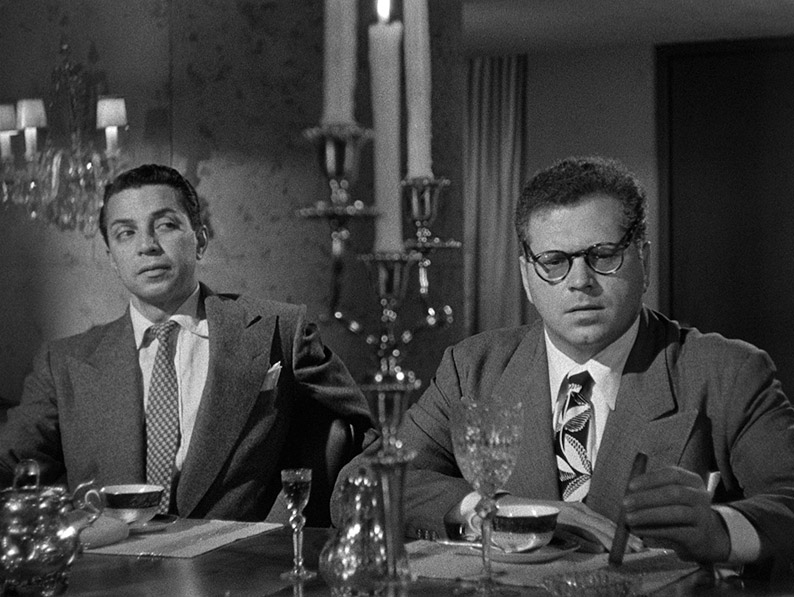
Image Gallery
18 screens of promotional stills, lobby cards, posters and a faked-up newspaper front page to push the notion that the filmmakers had to do figurative battle with the underworld to get this movie made.
Diary of a Sergeant (1945) (24:01)
A fascinating short film made for the War Department by 711 Ocean Drive director Joseph M. Newman about Harold Russell, an American soldier who lost both hands in a training accident, documenting the process of his recovery and readjustment to civilian life. Shot silent and with Russell’s probably scripted diary narrated by an uncredited Alfred Drake, its honesty about the difficulties that handicapped soldiers face is remarkable for its day. If Russell looks familiar it’s because he was hired by director William Wyler the following year to play handicapped World War II veteran Homer Parrish in the superb The Best Years of Our Lives, for which Russell won the Best Supporting Actor Oscar.
The Three Stooges in ‘Three Sappy People’ (1939) (17:21)
A wealthy man is throwing a dinner party and despairs at the wild antics of his ditzy socialite wife, Sherry (Lorna Gray), so calls on the urgent help of a trio of renowned but expensive psychiatrists, at whose premises telephone repairmen Curly, Larry and Moe just happen to be working when the call comes in. In need of some cash, they impersonate the doctors and rush round to the house, where their buffoonery so delights Sherry that she cancels her submarine trip (!) and delightedly invites them in with the amusing cry, “The last one in is a Republican!” There’s less violence than usual here, with half of the film devoted to a dinner party where the food-eating gags soon dissolve into an all-out cream cake fight. Not the boys’ funniest, but engaging nonetheless, and Sherry’s mad peals of laughter at just about everything our boys do is more amusing than it probably sounds.
THE MOB
Audio Commentary with Gina Telaroli
Filmmaker and archivist Gina Telaroli has plenty to say about what she describes up front as a great unsung noir, an opinion I am in complete sync with. She provides information on the actors and director Robert Parish, whose career she traces from his early days as an extra and editor and from whose memoires she quotes, citing lessons he learned from working with John Ford, which are really entertaining. There’s specific information on leading man Broderick Crawford, cinematographer Joseph Walker and screenwriter William Bowers, who gets even more generous coverage on the commentary for Tight Spot. There are a few sizeable gaps towards the end, but the rest is absolutely worth hearing.
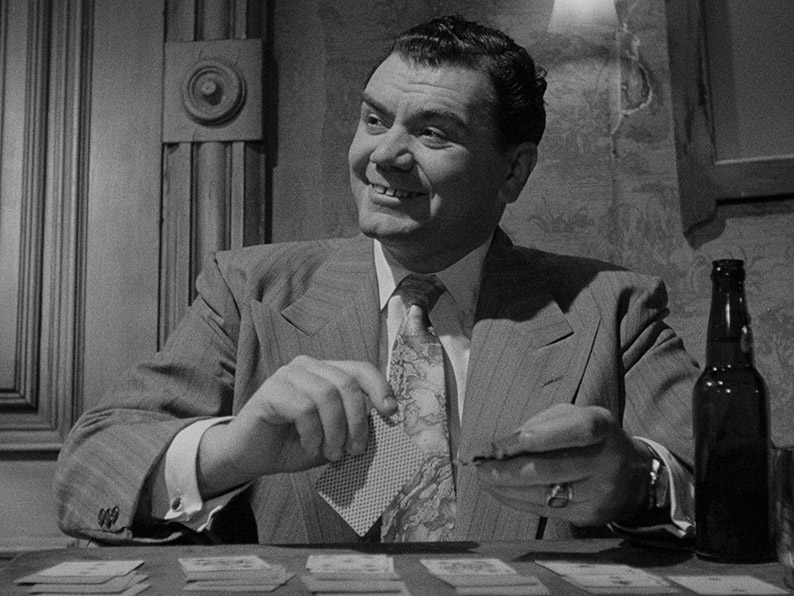
The Guardian Interview with Ernest Borgnine (78:21)
Conducted by Clyde Jeavons at London’s National Film Theatre on 21 May 2001, this is another of those “recorded for archival purposes’ inclusions where we’re asked to make allowances for, but the only bit I struggled with at all were the audience questions, and even they were made clear by the responses. It’s a most enjoyable chat that covers key points in Borgnine’s career, with a lengthy but engaging story about how he got into acting, his first experiences in Hollywood and his career-changing and Oscar-winning leading role performance in Marty. We get tales about cinematographer Jack Cardiff (who is in the audience), his work with Robert Aldrich on Emperor of the North and Sam Peckinpah on The Wild Bunch, and there are some amusing moments when he looks back at his five marriages, including his five-month one to Ethel Merman. He talks about the advantages of being a character actor, the converted bus he uses to travel round America, and is genuinely gobsmacked when an audience member askes him about his severely cut-down role in Gattaca, saying to him in all sincerity, “I don’t know how you remember that picture.”
Ernest Borgnine in Conversation (48:52)
Conducted by Adrian Wootton on 21 April 2009 at the BFI Southbank, this on-stage interview is as entertaining as the commentary, in part because Borgnine covers much of the same ground, sometimes on an almost word-for-word basis. The story of how he got into acting is a good example, but it has even more detail here, while key conversations he had with Spencer Tracy and Lee Marvin could almost have been lifted from the preceding extra. There’s a revealing story about what his good friend Frank Sinatra did for Lee J. Cobb when he suffered a heart attack, a cruel impersonation of Marlon Brando’s performance in The Godfather (“I could have done that!”), and the claim that it was his idea to have Spencer Tracy’s character use martial arts to fight him in Bad Day at Black Rock. If this is true, then deserved a serious pat on the back.
Theatrical Trailer (1:44)
A workmanlike trailer that introduces the main characters before moving onto the plot and which includes shots from the climax that fly by too quickly to really count as spoilers.
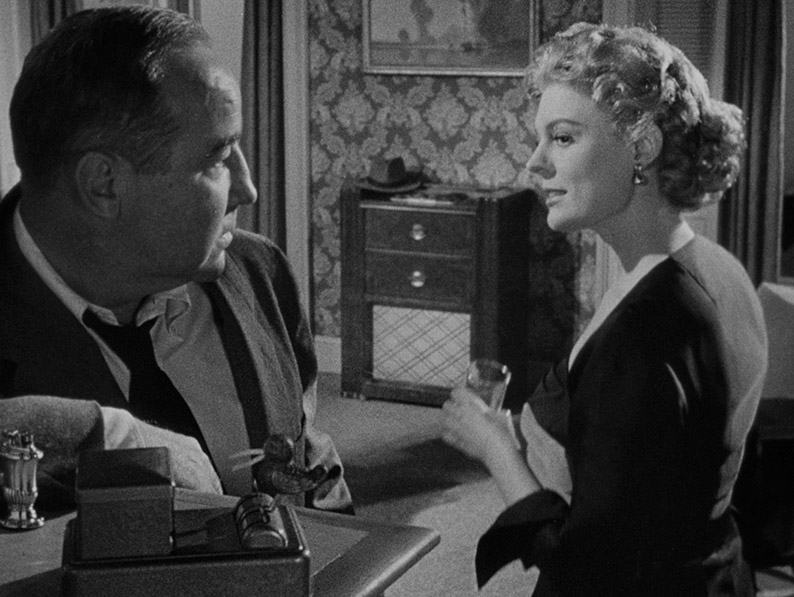
Image Gallery
22 screens of promo stills, garish lobby cards and posters.
The Three Stooges in ‘Hot Stuff’ (1956) (16:02)
The rulers of Anemia learn that their enemy Urania has developed a new rocket fuel that will give it air superiority, so decide to capture its developer, Professor Snead (Emil Sitka) and secure the formula for themselves. Over in Urania, meanwhile, undercover agents for the Uranian government, Shemp, Larry and Moe, are sent to guard the professor disguised as carpet fitters, but when Larry is mistaken for Snead by Anemian agents, all three are kidnapped and shipped to Anemia and ordered to develop the new rocket fuel. A surprising amount of plot for a Stooges short whose first half hasn’t aged too well, as Larry and Moe are invited by the two uniformed female officers to make themselves at home and proceed to sexually harass them for laughs, then move on to a series of gags built around the boys’ ogling of Snead’s attractive daughter, Hazel (Christine McIntyre). An extended gag involving Shemp being pulled in two directions and bodily distorted in the process is amusingly grotesque, however.
AFFAIR IN TRINIDAD
Audio Commentary with Lee Gambin
Author and film historian Lee Gambin, whose commentaries we always enjoy at Outsider, is back to look in his usual detail at a film he admits is not first-class noir and is hampered by a ‘clunky’ script, but which still has plenty to recommend it. We get plenty of detail on many of the actors, cinematographer Joseph Walker and director Vincent Sherman, whom Gambin reveals had a brief affair with Hayworth during the making of the film. Oh, the irony. There’s a lot of discussion about Hayworth’s dresses and costume designer Jean Louis, and the entire final half-hour is devoted to the life and career of lead player Rita Hayworth. It’s all of considerable interest, and I certainly hadn’t twigged that Valerie Bettis, who is so good in the film as the drunken Veronica Huebling, was also the choreographer of Hayworth’s two song-and-dance numbers.
The End of the Affair: Peter Ford on Glenn Ford (24:05)
Recorded at the Arthur Lyons’ Film Festival, Palm Springs Cultural Centre, California on 12 May 2012 following a screening of The Big Heat, this chat between host Eddie Muller and Glenn Ford’s son Peter has its share of entertaining and even revealing stories, all of which are doubtless expanded on in Ford’s book about his father, Glenn Ford: A Life. Ford Jr. occasionally has to wait for a very talkative Muller to get a word in, but when he does so he chats about his father’s early work, why an angry and drunken Orson Welles once stormed over to their house, and recalls that Fritz Lang made him his first martini even before he hit his teens. He reveals that his father kept a detailed diary his whole life, while the news that he had ‘relationships’ with a staggering 143 women will doubtless raise a few eyebrows. One of my favourite moments comes early when he recalls having Charlie Chaplin as a next-door neighbour as a child and that Chaplin once ran over his dog. “I’m a Buster Keaton man myself,” he remarks with a laugh.
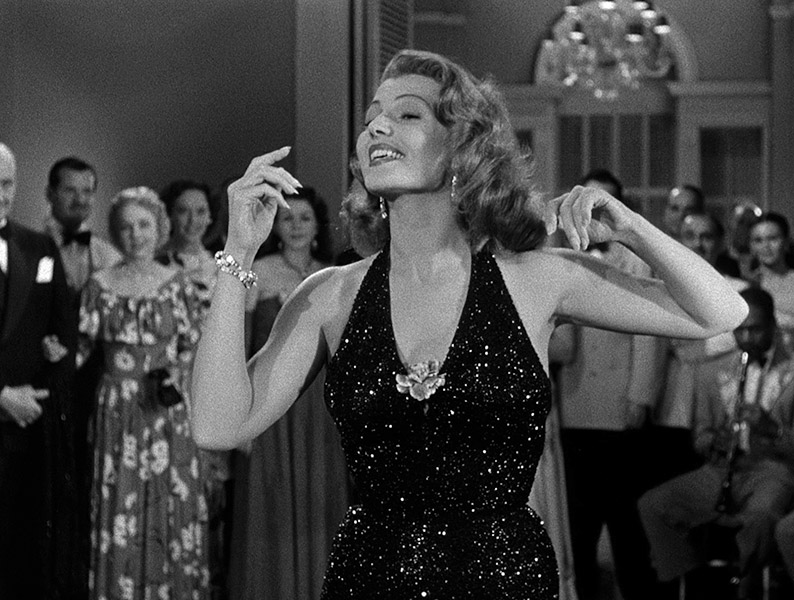
Theatrical Trailer (2:48)
A trailer that makes a deal out of the reuniting of Gilda stars Rita Hayworth and Glenn Ford and that includes a couple of unwarranted spoilers.
Image Gallery
49 screens (I never count the title screen on these, by the way) of promotional photos and posters, and there is an absolute ton of posters here.
Caribbean (1951) (25:01)
A documentary by the Crown Film Unit depicting the music, customs, industry and welfare of the West Indies, British Guiana, and British Honduras, included as a factual contemporary to Affair in Trinidad. Well shot and edited and with a seductive musical soundtrack of primarily local music, it’s very British narration by Ernest Eytle talks a lot about the products being produced in the region, but not about the companies and individuals who most financially benefit from them. Fascinating viewing nonetheless.
The Three Stooges in ‘Saved by the Belle’ (1939) (17:24)
In this nicely titled short, Curly, Larry and Moe play American clothing salesmen who are unsuccessfully peddling their wares in the tropical kingdom of Valeska. When they can’t pay their hotel bill they swindle the owner, Singapore Joe (LeRoy Mason), then get arrested for selling pillows as shock absorbers to citizens who are constantly being knocked off their feet by earthquakes. Imprisoned and waiting to be shot at dawn, they are aided by pretty undercover revolutionary Rita (Carmen LaRoux), who mysteriously has a bit of a thing for Curly, but even then things just won’t go to plan. One of the boys’ more elaborate and polished productions, it benefits from an amusing supporting cast (LaRoux is genuinely charming, and the uncredited French firing squad officer’s politeness had me giggling helplessly), solid production values and a string of visually amusing earthquake gags. The dialogue is also not without its pleasures, my favourites being a telegram whose innocent wording is misinterpreted as an assassination plot against Valeska’s president, and the moment when Singapore Joe angrily asks, “What kind of fool do you take me for?” and the bemused Curly responds, “Why, is there more than one kind?”
TIGHT SPOT
Audio Commentary with Nora Foire
An energetic and sometimes animated commentary from film historian Nora Foire, whose unbridled enthusiasm for Tight Spot prompted me to revisit the film and opened my eyes to aspects that prompted a rethink of my initial disappointment. This does see her almost performing her words at times – a trait not everyone will warm to – and occasionally praising directorial decisions and aspects of the performances that were not in any way unique to this film. That aside, this is a detailed and informative commentary, with Foire outlining changes made to the stage play on which the film was based, quoting from Ginger Rogers’ autobiography, providing some career details on screenwriter William Bowers and some of the actors, and analysing how the relationship between the two leads develops. She also cannily notes that Sherry behaves like a teenager in the presence of surrogate parents, and provides some useful background information on Virginia Hill, the real-life girlfriend of notorious gangster Bugsy Seigel and on whom Sherry is partly based.
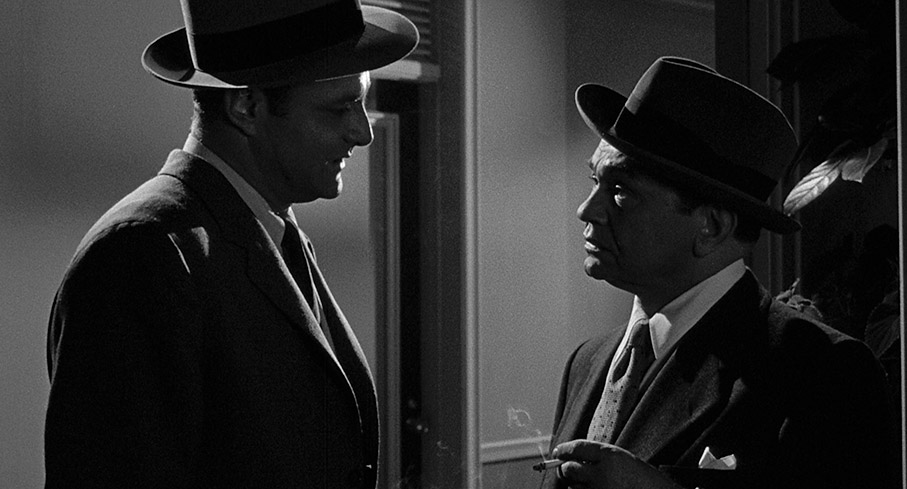
Theatrical Trailer (2:13)
A misleading trailer that initially paints the film as a screwball comedy but does get serious once the caption “Tense with suspense!” Pops up on screen. There are spoilers here, including a shot from the final scene.
Image Gallery
27 screens of promo stills, garishly colourised lobby cards, press book pages and international posters. Here I discovered that the film was titled Testimonio Fatal (Fatal Testimony) in South America and Le Gang du Crime in Belgium. I decided to follow this up and was delighted to discover that in Brazil it was known as Ratos Humanos (Human Rats). Now there’s a title for you.
The Senate Crime Investigations (1951) (61:27 total)
Excerpts from the unedited footage of the United States Senate Special Committee to Investigate Crime in Interstate Commerce, which was instigated in 1950 to look into organised crime and was popularly known as the Kefauver Hearings. These were screened on national TV and would go on to influence a number of noir film productions, including Tight Spot. You’ll hear the words “I refuse to answer on the grounds that it may tend to incriminate me” an awful lot during the course of the interviews, particularly the one with dismissed fireman John P. Crane, who was being investigated for the disappearance of $135,000 from fireman’s funds. Mind you, due to the age of the recordings and my head-ringing tinnitus, I have to admit to struggling to make out the questions and answers at times. This can be watched as a single one-hour programme or in four separate segments. Of particular interest in relation to Tight Spot is the appearance at the start of Part Four of Virginia Hill, a self-confidently sassy and glamorously dressed woman who associated with known mobsters and financially benefitted from it, and on whom that film’s lead character was partly modelled.
The Three Stooges in ‘Idiots Deluxe’ (1945) (17:32)
Moe is up in court for assaulting his roommates Larry and Curly, and in flashback tells the story of how a woodland hunting trip that was intended to calm his shattered nerves ended up with him being provoked into lashing out at them. Less manic than many of the Stooges’ more wildly violent works, with extended gags involving the preparing of breakfast in a woodland cabin and plenty of use made of a real and presumably tame bear that’s only doubled by a man in a bear costume for a couple of the more impossible shots. The best gag comes during the opening courtroom scene, when Moe and the judge compare injury scars, which made me laugh out loud.
MURDER BY CONTRACT
Audio Commentary with Farran Smith Nehme
Film critic and writer Farran Smith Nehme clearly relishes the opportunity to talk about a film whose fame she admits stems partly from its influence on the cinema of Martin Scorsese. She provides details on the actors, the credited and uncredited screenwriters (the blacklist rears its ugly head again here), lead player Vince Edwards, cinematographer Lucien Ballard and, especially, director Irving Lerner, as well as commenting on the score and the art direction. There’s some smart analysis of individual sequences, appreciation of the work of actors Frances Osborne and Cathy Browne, and a pertinent reminder of the influence that TV screenings of feature films was starting to have on the way those films were lit. Another very fine commentary.
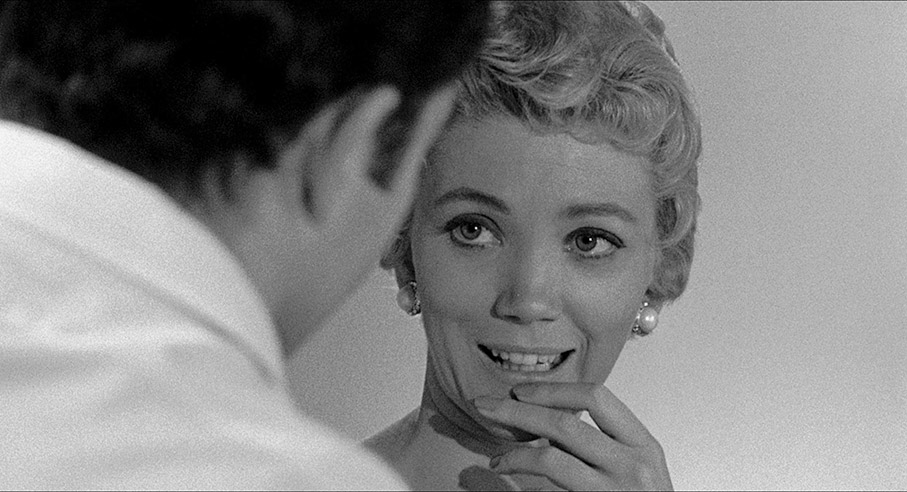
Introduction by Martin Scorsese (4:58)
Martin Scorsese recalls his first viewing of the film and comments on its qualities and its influence on his own work, specifically Taxi Driver. He also talks briefly about how Perry Botkin’s music helped shape Howard Score’s score for The Departed and director Irving Lerner’s final work as supervising editor on New York, New York.
Theatrical Trailer (1:55)
Massive spoilers aplenty in an otherwise straightforward trailer that nonetheless would get me to the cinema on its content alone
Larry Karaszewski Trailer Commentary (2:24)
Screenwriter Larry Karaszewski (Ed Wood, The People vs. Larry Flint) provides a brief appreciation of the film and notes its influence on the work of Martin Scorsese.
Image Gallery
Seven monochrome promotional stills, four wretchedly coloured lobby cards and two posters.
Swedes in America (1943) (17:09)
Structurally a little ramshackle, this Oscar-nominated short from Murder by Contract director Irving Lerner is a nonetheless heartfelt and interesting look at the contribution made to America by Swedish immigrants, as well as briefly outlining the history of their arrival on American shores. Swedish émigré Ingrid Bergman introduces and narrates the film, as well as visiting Swedish communities and promoting the benefits of the co-operative system. In the light of the sort of current anti-immigration bullshit being spouted both here and in America by people in positions of power who should know better, it feels downright progressive.
The Three Stooges in ‘Violent is the Word for Curly’ (1938) (17:51)
A string of preposterous coincidences and ineffectual car washing gags see Curly, Larry and Moe mistaken for visiting professors at a girls’ school, where they introduce the students to their brand of fun. For me, this is easily the weakest of the Stooges films in this set, and the inclusion of a nonsense musical number that probably seemed amusing decades ago doesn’t really help.
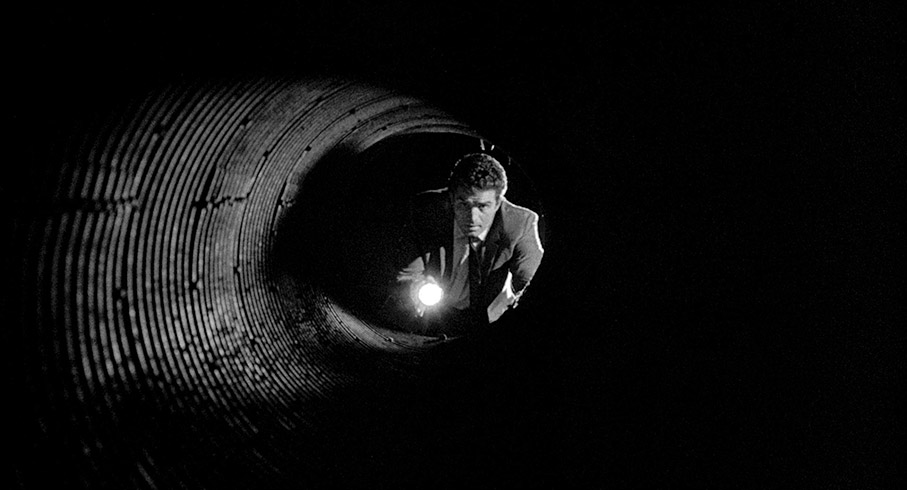
Also included is a whopping 118-page Booklet containing film credits, essays and other supplemental written material, with each of the films covered separately in chronological order. It kicks off with a concise essay on Framed by Professor of Film and Television Studies at the University of East Anglia, Melanie Williams, which is followed by a useful piece titled What Do We Expect When We Watch a Film Noir? by freelance writer and lecturer Ellen Cheshire, plus some useful extracts from an interview with Framed screenwriter Ben Maddow. In Filmed With a Gun at its Back, freelance writer Sabia Stent looks at 711 Ocean Drive, and in the first paragraph leans towards the notion that the threats against the production by criminal organisations might have a basis in fact after all. This is followed by a piece from a February 1950 issue of the Los Angeles Times that looks at the facts behind the race wire service and the claims made about attempts to halt the film’s production. Up next is an appreciation of The Mob by critic and author Simon Abrams, who describes the film as “a perfectly scaled B movie” (no argument here), after which are extracts from director Robert Parrish’s autobiography, Growing Up in Hollywood, which from what is shown here looks like an interesting read. In the amusingly titled What’s a Love Goddess Doing in a Dive Like This?, lecturer and researcher Kulraj Phullar looks at the career and image of Rita Hayworth and specifically her work on Affair in Trinidad. Sticking with this film are extracts from director Vincent Sherman’s autobiography, Studio Affairs: My Life as a Film Director, in which he recalls his dealings with studio boss Harry Cohn, the process of shaping the script and a little about the shooting of the film. Another great essay title comes next in the shape of A Responsible Cat Among the Dead Pigeons by writer and film programmer Tara Judah, who describes Vince Striker in Tight Spot as “more a coat hanger than a character” (ouch!), and once again the activities of the House of Un-American Activities worm their unpleasant way into the discussion. Extracts from various sources – the film’s press book, autobiographies, articles, etc. – in which the careers and politics of the film’s stars are discussed is followed by some colourful contemporary suggestions for exploiting the film. There’s a splendidly detailed analysis of Murder by Contract by renowned film writer David Thompson, a look at how the Hollywood Blacklist impacted on screenwriter Ben Maddow and how director Irving Lerner was suspected of involvement in Soviet attempts to infiltrate the Manhattan Project. There’s a most educational essay titled Film Noir and Non-Fiction by Anthony Neild, and a piece on The Three Stooges by Jeff Billington. As ever, the booklet is illustrated with publicity material and contains information on the transfers and credits not just for the features but all of the short films as well.
I was psyched for this second Columbia Noir box set from the moment its release was announced and it doesn’t disappoint one iota. Views on the films will as ever be a matter of personal taste, but all six are worth your while and at least half of them are absolute crackers and worth the price of the box set alone. Great movies, great transfers, great special features. Another absolute must-have from Indicator. Highly recommended.
<< Part 1: The Films
|